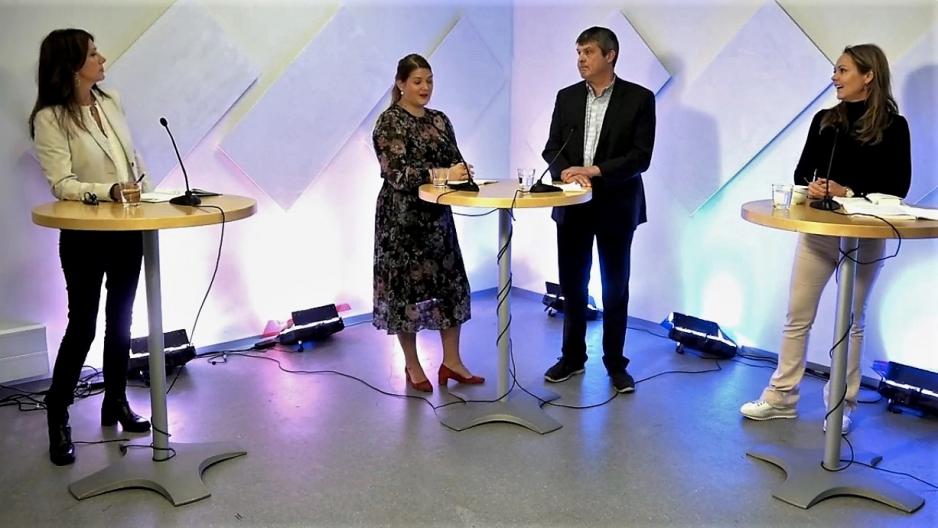NHO Signed Out From the High North Debate With A Long Yawn

NHO’s Anne-Cecilie Kaltenborn and Minister of Local Government and Digitalization Linda Hofstad Helleland traveled north, yet failed to understand where they were. From the left: Anne-Cecilie Kaltenborn, Managing Director of NHO Service and Trade; MP Cecilie Myrseth (Labor); MP Bengt Rune Strifeldt (the Progress Party), Minister of Local Government and Digitalization Linda Hofstad Helleland (Conservatives). Photo: Screenshot
Commentary: NHO, the Confederation of Norwegian Enterprise, presented its “road map for future enterprise” the other day. With a Director General who has previously been vocal in discussions about opportunities in the High North, it was safe to have high expectations. Though they proved to be wasted. NHO’s map for a future Norway does not even contain a side-track to the High North.
This is remarkable in and of itself, and perhaps even more so because Director General Erik Almlid has been worried about population development in the High North and also concerned with the fact that Northern Norway is largely ignored by the rest of the country. In his own manifesto, it is not about a region that is ignored – it is made invisible.
That is a political choice.
NHO could have lifted the debate
NHO places its trust in using general political tools and clearly sees not reason to contribute to the debate leading up to the government’s soon-to-be-expected whitepaper about the High North. It is due in November, and seen in combination with the [opposition] Labor Party’s recently presented draft Arctic policy, an exciting debate is stirred about the future of the High North. Both the government as well as the biggest opposition party still believe we need an Arctic policy, arguing from a combination of economics and security policy.
The whitepaper will be soaked with business politics, as is the draft policy from the Labor Party.
Based on its northern members, NHO could have added important points to the debate. But NHO does not want to be part of that debate.
The NHO road map resembles a party program because it is literally overflowing with non-committal phrases.
On a general level, NHO’s attempt at drawing a road map for enterprise is met with criticism, in particular from the Labor Party, which argues that NHO has presented a party-political manifesto. This is quite right in a number of ways, though not for the reasons claimed by Labor. Labor is in particular negative to cutting taxes and public expenses to benefit the private sector. It is true that the debate about the wealth tax follows political party lines. However, the discussion about the private vs the public sector does not. If Labor were to rise to power, the party will have to accept that public budgets have a shorter life span than a term in office, and that they require increased income from the private sector. The situation today is that we are nibbling away on next generation’s welfare.
Resembles a party program
The NHO road map resembles a party program because it is literally overflowing with non-committal phrases.
The part of the document pointing at solutions has fallen in love with non-committal words like ‘stimulate’ (19 mentions), ‘develop’ (76 mentions), ‘active’ (54 mentions) and ‘should’ (62 mentions).
I do not believe in magic spells, not even when uttered by a powerful organization like the NHO. Many of the overall goals of its document will receive wide political support. However, the tools with which to achieve these are a lot harder to get hold of.
Most people would agree that most things “should be developed, stimulated and activated”.
Which makes the entire manifest rather dull, in particular because it is presented by an organization that is not on the ballot and therefore should allow itself that extra pinch of salt. The current document hardly merits a debate at all.
Developed, stimulated and activated
Most people would agree that most things “should be developed, stimulated and activated”.
Thus, the document does not present any solutions to the acute challenges Northern Norway is facing. Stopping out-migration is an urgent matter, as is the need to strengthen infrastructure and the education sector in the High North. But NHO has all the time in the world.
Truth be told, NHO did a rather failed attempt at limiting the impression that the organization has no Arctic policy. Just the other day, the organization organized a debate in Alta titled “Roadmap for the Arctic”. Anyone bothering to watch this event on its Facebook stream – there were not many of us – could hardly have understood that it was about the High North at all.
Nor had the two panelists who had flown in for the occasion; NHO’s Anne-Cecilie Kaltenborn and Minister of Local Government and Digitalization Linda Hofstad Helleland. If they had any opinion at all about how the High North shall contribute to strengthening the national economy, they made sure to keep it to themselves.
They might as well have stayed at home.
This commentary was originally published in Norwegian and has been translated by HNN's Elisabeth Bergquist.

